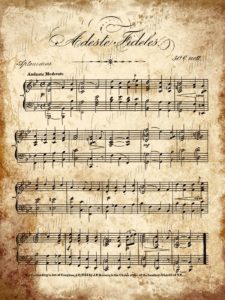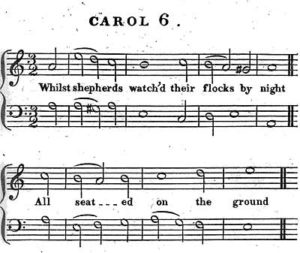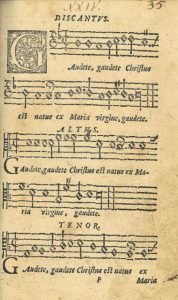Charlotte Kroeker, Ph.D.
Executive Director, Church Music Institute

The music of Advent and Christmas may be the last shared music in the English speaking world. Patriotic music, including the “Star Spangled Banner,” is almost unrecognizable as sung at sports events. Folk songs nearly have disappeared along with Pete Seeger and Peter, Paul & Mary who taught them to concert-goers. Christmas music remains, along with its remarkable ability to bring good cheer and sales at the cash register.
Note, however, that the secular texts of “Frosty” and “Silver Bells” live happily adjacent to music with Christian texts in commercial environments. In other contexts “Christmas” associations spawn protest, but not in commercial businesses. Likewise, “Amazing Grace” floods the airwaves without apology when tragedy strikes. Yet we are reminded that any text associated with memorable music makes that text ever more memorable, and especially when it is associated with a powerful emotional experience. Profoundly Christian messages speak loudly without comment given the right circumstances, perhaps because we underestimate the power of music, or simply let the music prevail. In these cases, for whatever the reason, I am glad.

The Peruvian, Mario Vargas Llosa, winner of the Nobel Prize in Literature in 2010, writes about the difference between specialization and progress (notably science), and the arts in his book Notes on the Death of Culture: Essays on Spectacle and Society. Whereas certain areas of life are superseded and replaced as progress is made (we give up 3-wheeled safety for the faster, 2-wheeled bicycle, for example), not so for art, nor for values and wisdom associated with art. When excellence in art is achieved, it also achieves timelessness. Shakespeare’s plays are as relevant today as when they were written; Mozart still thrills us; we find J.S. Bach’s profundity unending; the Bible continues to be a masterpiece after thousands of years.
So it is with Advent and Christmas carols and hymns. They contain truths for all time. Consider the Advent hymn “Creator of the Stars of Night, with its text from a Latin hymn of the 9th century and tune from Plainsong mode IV:
When this old world drew on toward night, you came but not in splendor bright,
Not as a monarch, but the child of Mary, blessed mother mild.
Or, the Olearius (1635-1711) text translated by Catherine Winkworth (1827-1878)
Comfort, comfort now my people; tell of peace! So says our God.
Comfort those who sit in darkness mourning under sorrow’s load.
To God’s people now proclaim that God’s pardon waits for them!
Tell them that their war is over; God will reign in peace forever.
The Isaac Watts (1674-1748) text with Lowell Mason’s tune that we know as “Joy to the World”:
No more let sin and sorrow grow nor thorns infest the ground;
He comes to make his blessings flow far as the curse is found.
The Edmund Sears (1810-1876) text with music by Richard Willis (1819-1900), stanza 3 of “It Came upon the Midnight Clear:
And you, beneath life’s crushing load, whose forms are bending low,
Who toil along the climbing way with painful steps and slow;
Look now, for glad and golden hours come swiftly on the wing;
Oh, rest beside the weary road and hear the angels sing!
Who can dispute the timelessness of these words to both acknowledge the human condition and also give hope to those needing joy in life? Thus we have a treasury of Advent and Christmas carols and hymns from long ago that have hardly gone out of style. They are as fresh as when originally written. The tunes will carry them in our memories and hearts. They will continue, forever in style.
